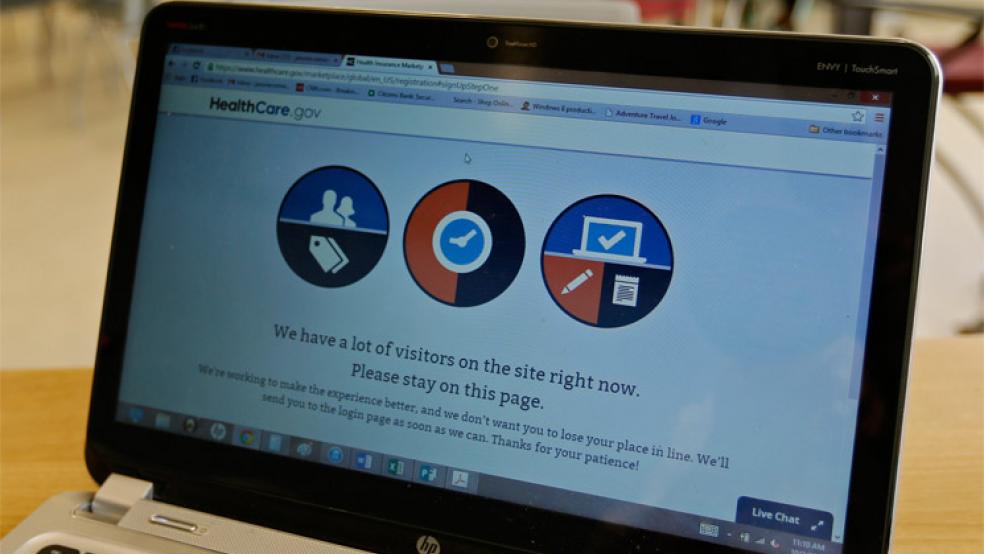You thought Healthcare.gov had problems?
A handful of state-run exchange websites—which cost nearly half a billion dollars to build—still don’t work, nearly seven months after they first went live.
Largely inoperable state exchange websites in Maryland, Massachusetts, Oregon and Nevada have racked up $474 million federal tax dollars so far, Politico first reported. The costs will continue to climb as states scramble to salvage the flailing websites or transition onto the federal exchange.
Related: Millions Wasted on Broken Obamacare Websites
Maryland will spend an additional $40 million to save its website, which has already cost $90 million. Nevada has spent $50 million to date and will decide in the coming weeks how much more it will spend on repair efforts. Massachusetts will pour an additional $121 million into fixing its severely troubled state portal, while also using the federal portal as a back up plan.
“Taxpayers will have to pay whether their state-based exchange fails or not,” said Josh Archambault, a senior fellow at the conservative Foundation for Government Accountability.
Meanwhile, Oregon’s website, which already cost $259 million, is so troubled that the state has opted to scrap the site entirely and spend an extra $5 million to use Healthcare.gov instead.
The Obama administration had intended for states using the federal portal to gradually transition away from HealthCare.gov and onto their own exchanges. However, since so many states had issues with their websites, it appears that the opposite is happening. Minnesota, Nevada and Rhode Island are all considering following Oregon and switching to HealthCare.gov. Not one of the 36 states using the federal exchange intends to set up their own exchanges.
Related: GOP Eyes Disastrous State-Run Websites
The switch from state-based exchanges to Healthcare.gov essentially means dumping millions of dollars down the drain to start over. And the federal government isn’t the only entity that’s been losing money on the failed or severely flawed websites. As Oregon Live noted, many insurance companies have poured money into customizing their own portals to help consumers navigate their state’s website during the open enrollment period.
Still, in some states, officials say it is cheaper than trying to salvage the lost-cause websites. CoverOregon executives, for instance, said repairing their website would cost an additional $75 million. In contrast, shifting to the federal portal would only cost about $5 million.
Policy experts argue that an unintended benefit of having more states use the federal portal is that it’s cheaper per enrollee. A report by Jay Angoff, a former Missouri Insurance Commissioner said it cost the federal government an average of $647 to sign up each enrollee on the federal portal, compared to the $1,503 per enrollee on the state-based exchanges.
As of November 2013, the federal exchange healthcare.gov. is estimated to have cost $677 million according to former HHS, Kathleen Sebelius.
Related: A Little-Noticed Glitch Could Derail Obamacare
Since 2011, the federal government has spent nearly $4.7 billion to help implement the exchanges, the Kaiser Family Foundation estimates. While some exchange websites like Oregon and Massachusetts suffered from nightmarish technical issues, others performed quite well.
It seems to all come down to how well a state managed its contractors and its exchange portals, since the Centers for Medicare and Medicaid Services gave them the freedom to be in charge of how their exchanges were designed and who would design them.
“CMS provided states with the flexibility to launch their Marketplace in a way that made the best use of its system’s capabilities at the time,” a CMS spokesperson said. “One of the main advantages of operating a state-based Marketplace was the ability to offer innovative designs that meet the needs of the states, it’s consumers, and it’s insurance market.”
While CMS had oversight over the states—requiring them to provide progress reports-- several including Oregon and Massachusetts still had severe management issues.
In fact, Oregon had so many management and oversight issues that its contractor is being investigated by the Federal Bureau of Investigations.
An earlier review by the federal government suggested that the contractor “may have boosted billings by ‘throwing bodies rather than skillset’ at problems,” Oregon Live reported.
A separate investigation into Maryland’s exchange by a federal watchdog is also underway.
The Congressional Government Accountability Office has also launched a probe into how well the federal government provided oversight over all of the troubled state exchanges.
Top Reads from The Fiscal Times:





